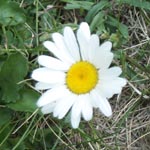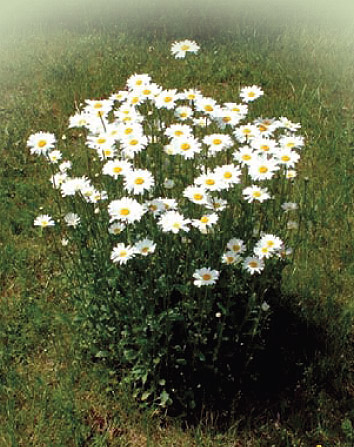Ox-eye Daisy
 Chrysanthemum leucanthemum syn. Leucanthemum vulgare
Chrysanthemum leucanthemum syn. Leucanthemum vulgare
Introduced from Europe in the early 1800's primarily as a grass seed contaminant, and subsequently spread as an ornamental, Oxeye daisy has become a serious invader of pastures and natural areas throughout North America. It is a perennial herb that reproduces both by seed and shallow rhizomes. Single plants quickly become patches that continually increase in size.
Plants flower June-August and its seed germinates throughout the growing season.
Ox-eye Daisy and the very similarly flowered Scentless Chamomile can be considered conspicuous, as there are no native white flowered daisies on the Canadian Prairies.
Identification
Stems: Multiple, un-branched stems grow upto 1M tall and are smooth, frequently grooved and generally hairless.
Leaves: Basal and lower leaves are lance shaped with "toothed" margins and petioles that may be as long as the leaves. The upper leaves are alternately arranged, narrow, and stalkless with wavy margins. Leaves progressively decrease in size upward on the stem.
Flowers: Flowers are borne singly at the end of stems and can be up to 5 cm in diameter,with yellow centers, and 20 to 30 white petals radiating from the center. The petals are slightly notched at the tip.
Seed: Individual plants can produce over 500 flat, black seeds that are viable in the soil for 2-3 years or more. Seeds have no dormancy requirement and are viable upon dispersal.
 Prevention
Prevention
The availability of closely related plants through the nursery and seed trade contradicts the perception of Ox-eye as an invasive plant. Shasta daisy is a cultivar (originated from) of Ox-eye and was originally sterile, but can revert back to being fertile.
Ox-eye plants can be found sold through nurseries and as seed in wildflower mixes. The two plants can cross breed, resulting in an invasive hybrid that is difficult to distinguish from either parent. This fact makes public awareness critical to prevention and control. Do not purchase nursery plants or seed labelled as Ox-eye daisy.
Consumers should carefully read the contents of so-called ‘wildflower' seed mixes and avoid those containing invasive ornamentals. Healthy, fertilized grass pastures are resistant to invasion.
Resources
2011 Rural Municipality Distribution Map
2010 Rural Municipality Distribution Map
Ox-eye Daisy MWSAÂ 2009 Survey Map
Best Management Practices 2010
Alberta Invasive Plant Council Fact Sheet
Â
Information above courtesy of the Alberta Invasive Plants Council.
Â
Back to Terrestrial Invasive Species List
Â
© Copyright 2004-2024 - CMS Made Simple
This site is powered by CMS Made Simple version 1.4.1


